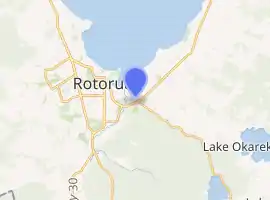Ngāpuna
Ngāpuna is a suburb in eastern Rotorua in the Bay of Plenty Region of New Zealand's North Island.
Ngāpuna | |
|---|---|
Suburb | |

| |
| Country | New Zealand |
| Local authority | Rotorua Lakes |
| Electoral ward | North |
| Population (2018)[1] | |
| • Total | 357 |
| Rotorua Central | (Lake Rotorua) | Ōwhata |
| Fenton Park |
|
Lynmore |
| Whakarewarewa |
The New Zealand Ministry for Culture and Heritage gives a translation of "the springs" for Ngāpuna.[2]
Marae
The suburb has two marae.
Ngāpuna or Hurunga o te Rangi Marae and meeting house is a meeting place for the Ngāti Whakaue hapū of Ngāti Hurunga Te Rangi and Ngāti Taeotu, and the Tūhourangi hapū of Hurunga Te Rangi and Ngāti Kahu Upoko.[3][4]
Hinemihi Marae and meeting house is a meeting place for the Tūhourangi hapū of Ngāti Hinemihi and Ngāti Tuohonoa), and the Ngāti Tarāwhai hapū of Ngāti Hinemihi.[3][4] In October 2020, the Government committed $4,525,104 from the Provincial Growth Fund to upgrade the marae and nine other marae, creating an estimated 34 jobs.[5]
Demographics
| Year | Pop. | ±% p.a. |
|---|---|---|
| 2006 | 327 | — |
| 2013 | 285 | −1.94% |
| 2018 | 357 | +4.61% |
| Source: [1] | ||
Ngāpuna had a population of 357 at the 2018 New Zealand census, an increase of 72 people (25.3%) since the 2013 census, and an increase of 30 people (9.2%) since the 2006 census. There were 102 households. There were 192 males and 165 females, giving a sex ratio of 1.16 males per female. The median age was 34.2 years (compared with 37.4 years nationally), with 84 people (23.5%) aged under 15 years, 69 (19.3%) aged 15 to 29, 165 (46.2%) aged 30 to 64, and 39 (10.9%) aged 65 or older.
Ethnicities were 23.5% European/Pākehā, 88.2% Māori, 3.4% Pacific peoples, and 4.2% Asian (totals add to more than 100% since people could identify with multiple ethnicities).
The proportion of people born overseas was 3.4%, compared with 27.1% nationally.
Although some people objected to giving their religion, 37.0% had no religion, 48.7% were Christian, 0.8% were Buddhist and 4.2% had other religions.
Of those at least 15 years old, 21 (7.7%) people had a bachelor or higher degree, and 63 (23.1%) people had no formal qualifications. The median income was $23,800, compared with $31,800 nationally. The employment status of those at least 15 was that 141 (51.6%) people were employed full-time, 21 (7.7%) were part-time, and 30 (11.0%) were unemployed.[1]
References
- "Statistical area 1 dataset for 2018 Census". Statistics New Zealand. March 2020. Ngapuna (201100). 2018 Census place summary: Ngapuna
- "1000 Māori place names". New Zealand Ministry for Culture and Heritage. 6 August 2019.
- "Te Kāhui Māngai directory". tkm.govt.nz. Te Puni Kōkiri.
- "Māori Maps". maorimaps.com. Te Potiki National Trust.
- "Marae Announcements" (Excel). growregions.govt.nz. Provincial Growth Fund. 9 October 2020.